The sleek new Airbus 321 rescued us from a six-hour purgatory in the labyrinth of Charles DeGaulle airport (so much arrogance over so little… even the croissants were cold and stale) and lofted us high over the cloud-wreathed Alps in the afternoon sun. Beside us was a young Cypriot woman studying French literature in Paris. At the time her rounded face and buxom figure didn’t recall our images of women from this ancient island. It was only later that we saw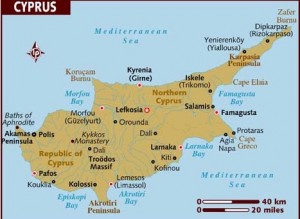 her face in paintings, pottery, and mosaics from its antique past. It was our first sense of walking into somebody else’s history, but for us there was a connection. Her family and mine shared a certain juncture in a common story. As the plane ushered us down the Adriatic coast and over the Greek islands, I remembered how my mother and her family had set out from New York in a steamship in 1923, only to collide with another ship, retreat back to port for a second try, land in Port Said, Egypt, travel overland through Palestine to a port on the coast, and sail to Famagusta, Cyprus. We were following in twenty-four hours what had probably taken them three weeks.
her face in paintings, pottery, and mosaics from its antique past. It was our first sense of walking into somebody else’s history, but for us there was a connection. Her family and mine shared a certain juncture in a common story. As the plane ushered us down the Adriatic coast and over the Greek islands, I remembered how my mother and her family had set out from New York in a steamship in 1923, only to collide with another ship, retreat back to port for a second try, land in Port Said, Egypt, travel overland through Palestine to a port on the coast, and sail to Famagusta, Cyprus. We were following in twenty-four hours what had probably taken them three weeks.
In the next eight days, with their photographs in hand, we retraced many of their steps, found their old living compound, visited the mine where my grandfather worked, and where we talked at length with its director, explored old Lefkosia (Nicosia), and experienced modern Cyprus, with its divisions, its troubled memories, its ecological opportunities, and its globalist aspirations. Over the next few weeks I will post vignettes of our trip and how it retrieved and reshaped the memories that were first instilled by my mother’s recollections of those early years.
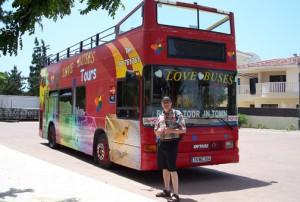 Though we landed at a brand new international airport in Larnaca, we were actually entering the island’s oldest urban area – the ancient Kition or Chittim – mentioned in the Bible and other places. In our first day we got acquainted with the city through a leisurely tour on the “Love Bus,” with its gruff and gregarious driver and efficient conductor. His Rube Goldberg grammar and colorful vocabulary mingled with the warm air of the near-constant Cyprus sun. We were immediately introduced into the sixth century Byzantine church of Panayia Angelikosti (“Church built by the Angels”), with its sparkling but partially damaged mosaic of the Virgin behind the iconostasis. In the neighborhood modern brick Orthodox churches basked in the suburban developments, products in part of the rush of refugees from the Turkish north after 1974.
Though we landed at a brand new international airport in Larnaca, we were actually entering the island’s oldest urban area – the ancient Kition or Chittim – mentioned in the Bible and other places. In our first day we got acquainted with the city through a leisurely tour on the “Love Bus,” with its gruff and gregarious driver and efficient conductor. His Rube Goldberg grammar and colorful vocabulary mingled with the warm air of the near-constant Cyprus sun. We were immediately introduced into the sixth century Byzantine church of Panayia Angelikosti (“Church built by the Angels”), with its sparkling but partially damaged mosaic of the Virgin behind the iconostasis. In the neighborhood modern brick Orthodox churches basked in the suburban developments, products in part of the rush of refugees from the Turkish north after 1974.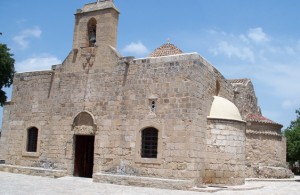
At the edge of a salt lake behind our hotel on the waterfront, sits a religious treasure – the Mosque of Sultan Hala Tekke – the burial place of a venerated relative of Muhammed, the Lady Umm Haram, who died there in 649. Supposedly the third most sacred pilgrimage spot in Islam, the Mosque was first built in the 18th century and then rebuilt in 1816. It lies in a peaceful grove of palm trees, its nearby bushes laden with bits of cloth left by pilgrims in the recent past. In its quiet interior the mighrab (a door feature pointing toward Mecca) as well as her tomb displayed stars of David on their borders. How the past can dissolve the stereotypes of the present! It was a sacred place that knows the meaning of prayer and openness to the transcendent mystery beyond even words. On the grounds archaeologists have discovered the remains of a Neolithic village (2500 to 7000 BC). The world here exists in layers, each one permeating the next in unknown ways.
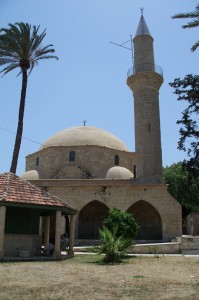 Before our trip was up we saw more churches and more mosaics, including Barnabas and, of course, Mary Magdalene in her red, the Virgin Mary in her blue. We ended our trip in the town center, where they were preparing for the festival of “Kataklysmos,” which occurs on the week of Pentecost. It seems to be a mélange of Memorial Day, Mardi Gras, and the Fourth of July that ushers in the summer season.
Before our trip was up we saw more churches and more mosaics, including Barnabas and, of course, Mary Magdalene in her red, the Virgin Mary in her blue. We ended our trip in the town center, where they were preparing for the festival of “Kataklysmos,” which occurs on the week of Pentecost. It seems to be a mélange of Memorial Day, Mardi Gras, and the Fourth of July that ushers in the summer season.
Our first day introduced us to the fact that Cyprus is crawling with cats, leading, we hoped, to a scarcity of rats and mice. In addition, there are the Russians, Romanians and other Easter Europeans. Real estate ads are in English and Russian. The hotel staff, charming and very helpful, were Rumanian. The guests were largely Russian tourists, with their habit of filling their pockets with breakfast eggs and rolls, a product, we assumed, of a deprived past that had robbed them of a morality of other-concern. How they will ever construct a democracy and economy with a minimum level of trust and Rotarian ethics is beyond me.
So did Cyprus welcome us, with a polyglot past and present, an openness to a globalist future, and a deep sense of both tragedy and individual dignity. In my next post I will tell you about our trip into the Troodos Mountains, where my mother spent much of her summers here.

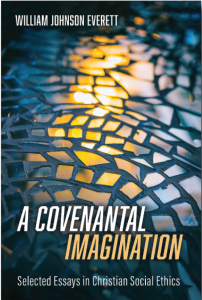
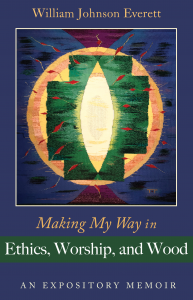
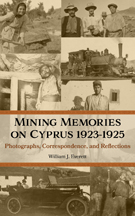
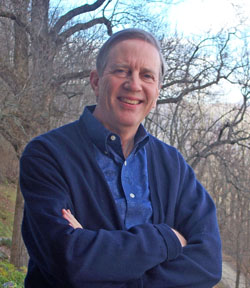
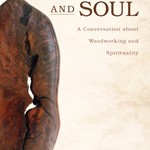
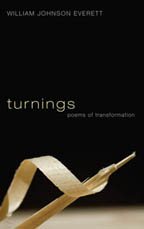
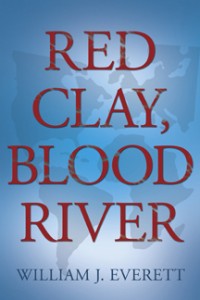 Red Clay, Blood River
Red Clay, Blood River
Great to hear about your early days in Cyprus! Keep us posted. We leave for London next week but will be in touch. And have a wonderful visit. John
Not often does one get a “poetic” travelogue, like this one from Cyprus. Thanks, Bill!